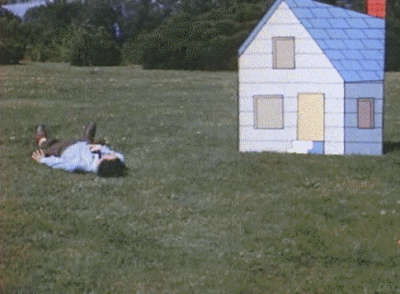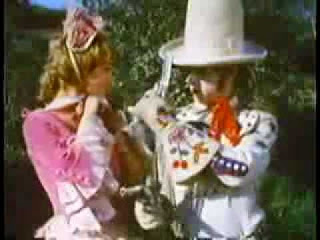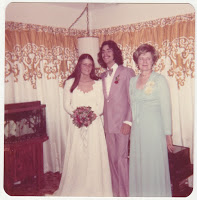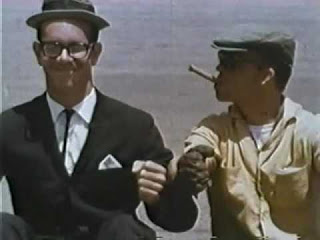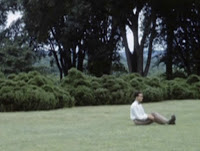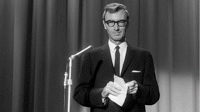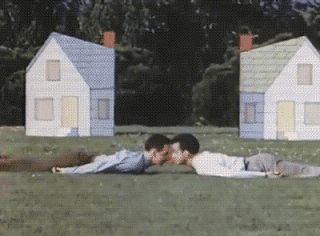Oddball Films Media
•
Jul 16, 2016
Oddball Films presents Humanimation: Stop-Motion Pixilation, a super fun and funny program of stop-motion animation utilizing human actors as puppets, animated one frame at a time. Films include four shorts from Academy Award winning luminary Norman McLaren and the National Film Board of Canada: Neighbors (1952) a grim tale of two men feuding over a beautiful flower, Two Bagatelles (1953) with two delightful tales of men dancing and flying over a field of grass, A Chairy Tale (1957) featuring music by Ravi Shankar, and his hilarious Opening Speech (1961) with an out of control microphone. From the hilarious and Oscar-nominated duo Leo Janson and Chuck Menville come four raucous shorts of speed racers without their cars in Stop Look and Listen (1967), cowpokes without their horses in the Western spoof Blaze Glory (1969), bikers without their motorcycles in Vicious Cycles (1967), and high-flying superheroes in Captain Mom (1972). Other films include Mike Jitlov's eye-popping high-speed chase The Wizard of Speed and Time (1979), the Encyclopedia Britannica short Let's Pretend: Magic Sneakers (1969) featuring a high speed pair of enchanted Converse, and a section of Six Filmmakers in Search of a Wedding (1971). Plus more! All films screened on 16mm from our stock footage archive.
Date: Thursday, July 21st, 2016 at 8:00pm
Venue: Oddball Films, 275 Capp Street San Francisco
Featuring:
Four Wild Shorts by Charles David “Chuck” Menville and Len Janson
In the 1960s two friends, Charles David “Chuck” Menville and Len Janson revived the then-dead art of stop motion pixilation animation. Pixilation, the animation of living beings, and object animation, was nothing new to film, but Menville and Janson took the process to a whole new level both technically and creatively.
Their first collaboration, Stop, Look and Listen (1967), was nominated for an Academy Award. In this short film the main characters “drive” down city streets in invisible cars. It’s
ostensibly a public safety film that informs the audience of the merits of following the rules of the road. Wildly inventive use of stop motion techniques-- use of human bodies as vehicles(!) make this eye-popping short a sensation.
Also screening is Blaze Glory (1969), a spoof of Westerns. This time our heroes and villains ride around, without horses in sped up style. The film was a hit short at Midnight Movie screenings in the early 70s.
Our third film, Vicious Cycles (1967), features a gang of hard-core bikers intimidating a prissy motor scooter club. The films represent a revived genre and exuberant, quirky style.
Captain Mom (Color, 1972)
A bizarro superhero spoof from Oscar-nominated pixilation duo Len Janson and Chuck Menville (Stop, Look and Listen, Blaze Glory). Captain Mom (played by Menville himself) is on a romantic mission as he signs up for a superhero dating service and lands the she-hulk of his dreams!
Four from Norman McLaren
Neighbors (Color, 1952)
Utilizing the new technique of animating live actors (fellow NFB animators Paul Ladouceur and Grant Munro), the Oscar-winning Neighbours is Norman McLaren’s most famous and important film. A parable of aggression and war, two men sit peacefully in lawn chairs when a flower appears on the boundary of their properties. In the quarrel that ensues the flower is destroyed, and the men turn to demons, destroying everything, including themselves.
Two Bagatelles (Color, 1953, Norman McLaren)
Two experiments in pixilation (animating humans and objects through stop-motion photography) co-directed by animation genius and founder of the National Film Board of Canada Norman McLaren and filmmaker and actor Grant Munro (who coined the word “pixilation”). In the first, (which was inspired by their award-winning film NEIGHBOURS/VOISINS) a man waltzes to a synthesized version of a Johann Strauss melody; in the second, he moves around playfully to a tune played on a street organ.
A Chairy Tale (B+W, 1957)
Shot partly with pixilation and partly at 12 frames a second this surrealistic fable is the directorial collaboration of three of the geniuses of the National Film Board of Canada; Norman McLaren, Claude Jutra and Evelyn Lambert. The musical accompaniment is by Indian musicians Ravi Shankar, Chatur Lal, and Modu Mullick. In this film, a chair, animated by Evelyn Lambart, refuses to be sat upon, forcing a young man to perform an acrobatic and comedic dance with the chair.
“A Chairy Tale” won the Canadian Film Award for Best Arts and Experimental Film, as well as a BAFTA Special Award, and earned an Academy Award nomination for Live Action Short Subject.
Opening Speech (B+W, 1961)
Featuring Norman McLaren himself, he tries to master a recalcitrant microphone at the opening of the 1st Montreal International Film Festival. At every turn, McLaren finds himself duped by the wily mic. McLaren gives a performance worthy of Tati’s Monsieur Hulot or Peter Seller’s Clouseau.
Let's Pretend: Magic Sneakers (Color, 1969)
Alternately evoking Norman MacLaren's stop-motion live action films, The Wizard of Oz and The Red Balloon, Magic Sneakers tells the tale of a boy and his fears and the special power of some castoff Chuck Taylors. The exotic tabla music gives the pathos that bit of "far out" so prized in this period of school film.
The Wizard of Speed and Time (Color, 1979, Mike Jitlov)
A young man in a green wizard costume runs throughout America at super speed. Along the way, he gives a pretty girl a swift lift to another city, gives golden stars to other women who want a trip themselves and then slips on a banana-peel, and comically crashes into a film stage, which he then brings to life in magical ways. Jitlov is a special effects technician, and produced all of the special effects in the film himself, many through stop motion animation.
This mind-blowing, celebratory short was originally shown as a segment of an episode of The Wonderful World of Disney and later extended to a feature length film.
Six Filmmakers in Search of a Wedding (Color, 1971, excerpt)Six rapid-fire shorts covering the same wedding - some naturalistic and gentle and others more comedic and satirical (one is done in pixilation with background music by famed Canadian animator Derek Lamb; another is crudely animated with photos and drawings moved across stationary backgrounds). Interesting fashions, very Seventies.
Curator’s Biography
Kat Shuchter is a graduate of UC Berkeley in Film Studies. She is a filmmaker, artist and esoteric film hoarder. She has helped program shows at the PFA, The Nuart and Cinefamily at the Silent Movie Theater and was crowned “Found Footage Queen” of Los Angeles, 2009. She has programmed over 250 shows at Oddball on everything from puberty primers to experimental animation.
Oddball Films is a stock footage company providing offbeat and unusual film footage for feature films like The Nice Guys and Milk, documentaries like The Black Panthers: Vanguard of the Revolution, Silicon Valley, Kurt Cobain: The Montage of Heck, television programs like Transparent and Mythbusters, clips for Boing Boing and web projects around the world.
Our screenings are almost exclusively drawn from our collection of over 50,000 16mm prints of animation, commercials, educational films, feature films, movie trailers, medical, industrial military, news out-takes and every genre in between. We’re actively working to present rarely screened genres of cinema as well as avant-garde and ethno-cultural documentaries, which expand the boundaries of cinema. Oddball Films is the largest film archive in Northern California and one of the most unusual private collections in the US. We invite you to join us in our weekly offerings of offbeat cinema.
